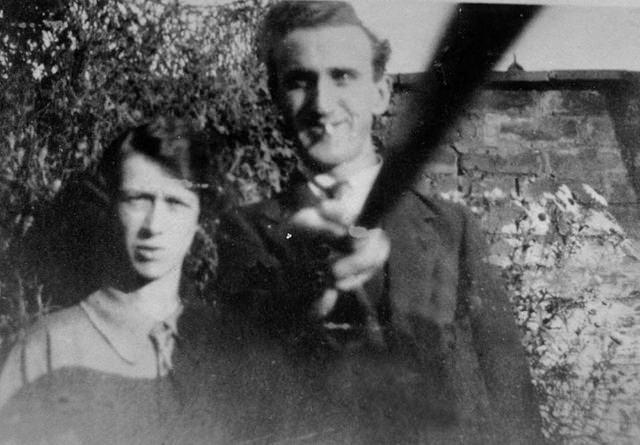Unlock the Magic in Your Story Now
Get the Free 20 questions to Ask Before Launching Your Idea workbook when you sign up for occasional updates.
Get the Free 20 questions to Ask Before Launching Your Idea workbook when you sign up for occasional updates.
The Unchanging Nature Of Business
filed in Strategy
 It’s a cool November day in 2014, and a young couple pause on a suburban street to snap a selfie with an iPhone 5C.
It’s a cool November day in 2014, and a young couple pause on a suburban street to snap a selfie with an iPhone 5C.
90 years earlier in a garden in Warwickshire, England (circa 1925), Arnold and Helen Hogg attach a Box Brownie camera to a long stick and take their selfie.

When we think about how to sustain and grow our businesses by remaining differentiated, competitive and relevant, we often begin by wondering how to leverage advances in technology to innovate. While we can’t always reliably plan for a future that hasn’t arrived, we can act on the things we know that are unchanging and constant. The people we serve will always want to be seen and acknowledged, valued and loved. If we begin with that end in mind we’re on the right path.
Images by Robert Couse Baker and Alan Cleaver
Share this article
Why Do Your Customers Buy?
 How thirsty is the college student who pays almost $5 for a Caramel Macchiato at Starbucks?
How thirsty is the college student who pays almost $5 for a Caramel Macchiato at Starbucks?
Did the fitness instructor really need to upgrade his iPhone 6 to a 7?
Can the mother who religiously gives her kids vitamins each morning prove that they work?
When the CEO hires a contract lawyer is she paying for the piece of paper or the peace of mind his expertise will give her?
The Oxford English Dictionary defines value as; “The regard that something is held to deserve; the importance, worth, or usefulness of something” and its “material or monetary worth”. It turns out that the immaterial—the perception of value that’s created by wants not needs, feelings, not facts, and beliefs, not proof is what drives people to act. We recognise this behaviour in ourselves and witness it in the choices we make every day.
And yet when it comes to marketing our products and services—because it’s harder to do the work of understanding our customer’s motivations than it is to talk about what we want to sell, we lead with features, facts and proof. If value is a story customers tell themselves, then our innovation and marketing must acknowledge and respond to that internal narrative.
Image by Jack Fussell.
Share this article
How To Build A 21st Century Brand
filed in Storytelling, Strategy
 Forty years ago a brand was an identifier. Branding was what we did to the outside of a product or service after it was conceived and created. Brands became tales woven to increase visibility and memorability using design, clever copy, print and TV advertising to make sure the product was known by the majority of prospective customers. This is how traditional brands like Cadbury, Coca-Cola, Visa and Hertz became top of mind and won big in the days of traditional advertising.
Forty years ago a brand was an identifier. Branding was what we did to the outside of a product or service after it was conceived and created. Brands became tales woven to increase visibility and memorability using design, clever copy, print and TV advertising to make sure the product was known by the majority of prospective customers. This is how traditional brands like Cadbury, Coca-Cola, Visa and Hertz became top of mind and won big in the days of traditional advertising.
The following list is what branding was traditionally designed to achieve:
Objectives Of Traditional Branding
- Awareness
- Attention
- Authority
- Majority
- Average
- Profit
- Dominance
- Outside in
- Shareholder value
- Single bottom line
But this isn’t how you build a beloved brand now. Today a brand is a promise that people align with, believe and invest in and branding begins from the inside out. 21st century brands are purpose-driven. They have a reason to exist beyond making a profit, and they no longer aim to appeal to the average or everyone. Here’s what 21st century branding sets out to do:
Objectives Of Branding in the 21st Century
- Affinity
- Alliance
- Trust
- Individuals & Tribes
- Edges
- Purpose
- Relevance
- Inside out
- Customer-centric
- Triple bottom line
If the nature and function of brands have changed, then the process for developing brands and brand stories must evolve too. We’ll be on our way when we begin by prioritising the objectives on the second list. A brand story is no longer like the top coat of gloss paint applied at the last moment to make the surface shinier and more immediately attractive. It’s the undercoat that often nobody sees, but which allows the brand to endure.
Image by NASA HQ.
Share this article
The Good Marketer’s Dilemma
filed in Marketing, Storytelling
 People (including you and me) often convince themselves that they make logical decisions about what to buy based on things like quality and price. If this were true, then there would be no need for businesses to invest in packaging, design or user experience.
People (including you and me) often convince themselves that they make logical decisions about what to buy based on things like quality and price. If this were true, then there would be no need for businesses to invest in packaging, design or user experience.
Packaging, design and copy tell a story that reinforces a worldview—enabling the customer to rationalise purchasing decisions. There’s a reason the body moisturiser comes in a gold tinted bottle. It reminds the buyer of the soft ‘sun-kissed summer skin’ she longs to achieve. The marketing copy on the front reinforces the message with descriptions of precious oils, intense nourishment and radiant glow.
The ‘RESULTS’ achieved by other consumers (41 of them who used the product for a week, if you’re paying attention to the fine print and asterisks), are detailed on the back.
+INTENSE NOURISHMENT: reduced dryness 53%*.
+RADIANT GLOW: 78% of women noticed a difference.**
+NOICEABLE SMOOTHNESS: 93% of women agree.**
The stories marketers tell are assurances upon which customers base their expectations. So while we might make the sale today, if the story doesn’t live up to the expectations we’ve created, then we risk sacrificing customer loyalty and sustainable business growth for that quick win.
We (you and me) make up the companies, businesses and organisations that help people (who deserve to live in an asterisk-free world) to create habits, decide and choose. Our marketing not only communicates our value it also demonstrates our values. We’re responsible for both what’s inside the bottle and the effect of the stories we tell on the outside. That very fact means we’re more powerful than we know. Good marketers live with this dilemma every day. It’s worth remembering that it’s easier than we think to reach a sales target or to get an idea to spread and much harder to be proud that we did.
Image by Thomas Hawk.
Share this article
What’s Missing?
filed in Innovation, Strategy
 The patisserie opened with great fanfare and then fell flat. The brand had an international reputation, was selling a half decent product in a good location and yet customers didn’t feel like they had a reason to come back. They couldn’t put their finger on it, but the cafe just had no soul.
The patisserie opened with great fanfare and then fell flat. The brand had an international reputation, was selling a half decent product in a good location and yet customers didn’t feel like they had a reason to come back. They couldn’t put their finger on it, but the cafe just had no soul.
It’s easy to get into the habit of working on our advantages. We often reassure ourselves by focusing on strengths or paying attention to the best performance metrics. This reticence to address our shortcomings can blind us to opportunities to do better.
On the journey to perfecting an unforgettable dish, the question talented chefs ask themselves most is; “What’s missing? Many of the groundbreaking ideas and innovations of our time from raw chocolate to bottled water, the iPod to the Tesla were born from understanding not just what was lacking in the product, but also what was missing in the life of the customer and how she might want to experience it differently.
We uncover breakthrough ideas when we address the questions that haven’t already been answered.
Image by Jaume Escofet.
Share this article
How To Communicate Value Beyond Describing Features And Benefits
filed in Marketing, Storytelling
 In an attempt to gain the trust of prospective customers we often resort to simply telling them about our product’s features and benefits. While describing value might seem like the easiest way to communicate it, the simplest strategy isn’t always the most compelling one.
In an attempt to gain the trust of prospective customers we often resort to simply telling them about our product’s features and benefits. While describing value might seem like the easiest way to communicate it, the simplest strategy isn’t always the most compelling one.
When value is demonstrated rather than described it immediately becomes more relatable. Your customers need to know more than how the thing works—they want to understand how that functionality creates a change for them. Showing is more powerful than telling because it reflects the customer’s desire, problem or dilemma (alongside your potential solution) back to him. This is why success stories build trust in a way marketing copy never can.
10 Alternative Ways To Communicate Value
1. Show the number and calibre of customers you’ve worked with and impacted.
2. Use case studies to demonstrate the results you’ve helped customers to achieve.
3. Create product review, press and feedback pages on your website.
4. Publish customer testimonials and positive feedback from social media.
5. Share images and video of the product in use.
6. Encourage customers to share their photos, videos, and product reviews online.
7. Create pilot programs, free webinars or white papers to showcase your skills and expertise.
8. Show how customers use and enjoy your products or services.
9. Create content that answers customer’s questions.
10. Celebrate your audience.
Harley Davidson’s most powerful marketing isn’t the detail about engine size, speed or low-end torque that’s written in the brochure—it’s the stories riders tell about the feeling they get when they ride one. And often your most effective marketing may not even be done by you.
Image by Andy.
Share this article
The Power Of Story To Find Value
filed in Marketing, News, Storytelling
 As business leaders, entrepreneurs and marketers we’re used to leveraging the power of story to describe value. We mostly use stories as a tool for telling. Because we believe the way to succeed is to be more vocal and visible, we create campaigns, sales letters, videos and press releases. We craft headlines, posts and tweets in an attempt to create awareness.
As business leaders, entrepreneurs and marketers we’re used to leveraging the power of story to describe value. We mostly use stories as a tool for telling. Because we believe the way to succeed is to be more vocal and visible, we create campaigns, sales letters, videos and press releases. We craft headlines, posts and tweets in an attempt to create awareness.
All the while we’re missing opportunities to use stories to make us more aware, to notice and to listen out for what the world is waiting for or wants from us. Yes, it’s possible to use a story to portray us as the hero, but it’s also a powerful tool for finding out how to be one. By harnessing story in a counter-intuitive way to listen rather than trying to be heard, we discover what’s missing. We suddenly see how we can create value and find opportunities to succeed by serving in ways others have overlooked. This is how a groundbreaking hospitality company was born, not by building more hotel rooms, but by creating a greater sense of belonging, and why a book about tidying up has been on the New York Times Bestseller list for 109 weeks.
The amount of noise in the world, the data and cues we’re meant to pay attention to can feel like navigating a strange city in a blizzard. But when we allow ourselves to stop for a second to get our bearings we often find the right path. Just as in the stillness that follows a storm, the snow settles on branches and surfaces, reflecting light, bringing everything into sharp relief and revealing details we just hadn’t seen before.
Image by Linh Nguyen.
Share this article
Sustainable Attention
filed in Marketing, Storytelling
 The box office was due to open on Monday morning. The first fans took their place at the front of the line at 3 pm on Sunday. By midnight a hundred had gathered, and at dawn, the line snaked around on itself, as people armed with deck chairs and milk crates, queueing for the one-off $20 theatre tickets hugged the walls of the entire city block. TV cameras and newspaper reporters arrived, and word spread to nearby city offices encouraging casual theatregoers to join the line as late as 2 pm. I doubt they even reached the top of the queue before closing time.
The box office was due to open on Monday morning. The first fans took their place at the front of the line at 3 pm on Sunday. By midnight a hundred had gathered, and at dawn, the line snaked around on itself, as people armed with deck chairs and milk crates, queueing for the one-off $20 theatre tickets hugged the walls of the entire city block. TV cameras and newspaper reporters arrived, and word spread to nearby city offices encouraging casual theatregoers to join the line as late as 2 pm. I doubt they even reached the top of the queue before closing time.
There’s no doubt selling cheap tickets to the preview created a lot of buzz in the media about the show, getting the kind of attention most brands only dream of. The immediate, measurable impact and the dollar value of the exposure will have been considerable. But what happens once the cheap tickets are gone, and all that’s left is the empty milk crates piled outside the theatre doors?
We believe that attention is fuel for business growth. But it’s important to remember that there are different types and quality of attention and many ways we can buy or earn that attention. Just as we can opt to eat a chocolate bar that will give us an instant energy boost, over a plate of lentils that will nourish us. We can look for ways to tell our story that will maximise noise for a day. Or we can choose to do work over time that garners the kind of attention that sustains us.
Image by Ruth Geach.
Share this article
Buzzworthy
filed in Storytelling, Strategy
 On my recent travels in country Victoria, I came across an incredible artisan gluten free bakery miles from nowhere. The owners baked only three types of bread. The bakery sold fresh salad rolls and quality coffee on the premises.
On my recent travels in country Victoria, I came across an incredible artisan gluten free bakery miles from nowhere. The owners baked only three types of bread. The bakery sold fresh salad rolls and quality coffee on the premises.
As we got chatting about how well they had nailed their story, the owner began to apologise for their social media presence. “We know we need to get onto that,” she said. And while she’s right about the need to give her far-flung customers an opportunity to connect and a way to share online—there is no more powerful presence than a great product designed with the customer in mind.
It’s tempting to jump ahead to creating the buzz we believe we need to succeed and harder to do the work of understanding what makes a product buzzworthy in the first place.
Image by Dave Bloggs.
 My husband, who is a doctor has been trialling ways to improve the patient experience at the practice where he works one day a week. There are many things about the experience that are out of his control. He can’t control how the receptionist speaks to the patient on arrival, cut the waiting time or shush crying babies in the waiting room. But there are moments in between where he can have an impact.
My husband, who is a doctor has been trialling ways to improve the patient experience at the practice where he works one day a week. There are many things about the experience that are out of his control. He can’t control how the receptionist speaks to the patient on arrival, cut the waiting time or shush crying babies in the waiting room. But there are moments in between where he can have an impact.